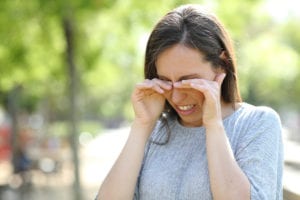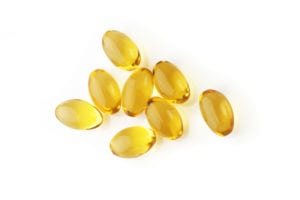We think tears are only a sign of emotion, but that’s not how our eyes see them. Our eyes need a continual stream of tears for lubrication, cleansing, and protection. Healthy eyes are continually bathed by tears produced by a combination of three glands located above both eyes. Sometimes a person has a decrease in tear production or the tears produced are of poor quality. The result is a condition called Dry Eye.
What Are the Symptoms of Dry Eye?
These are the signs and symptoms of Dry Eye, which usually affects both eyes:
- Stinging, burning, or scratchy sensation in your eyes
- Stringy mucus in or around your eyes
- Sensitivity to light
- Eye redness
- A sensation of having something in your eyes
- Difficulty wearing contact lenses
- Difficulty with nighttime driving
- Watery eyes
- Blurred vision or eye fatigue
The Causes of Dry Eye
In humid Ocala, you wouldn’t think drying eyes would be a problem, but the causes are internal more than external. Dry Eyes can develop when the tear ducts are not producing a sufficient number of tears. Or the condition can be due to a chemical imbalance in the tears themselves. Natural tears require a particular chemical balance to lubricate the eyes efficiently. Sometimes, your eyes are actually overproducing tears due to the irritation in your eyes, but the tears aren’t the right consistency to help.
Aging makes us all more likely to develop Dry Eye — it’s more common in people over the age of 50. It can be a side effect of taking certain medications, a sign of another medical condition, or the result of an injury.
Women tend to get Dry Eye more than men due to the hormonal changes that take place during pregnancy and menopause. Oral contraceptives can also lead to inconsistent tear ingredients.
These are other causes of Dry Eye:
- Antihistamines, decongestants, and blood pressure medications
- Environmental conditions such as smoke, wind, and excessive sun
- Eye injury
- Long-term contact lens use
- Eye or eyelid surgery
- Conjunctivitis or keratitis
- Rheumatoid arthritis, diabetes, Sjogren’s syndrome, thyroid disease
Why Does Tear Quality Matter?
We take tears and the function of our eyelid blinking for granted. But these bodily actions are critical for the health of our eyes. Every time your eye blinks, a film of tears washes down the front of the eyeball, keeping it smooth and clear. When healthy, these tears consist of three layers: an oily layer, a watery layer, and a mucus layer. The oily layer, produced by the Meibomian glands, is the outside layer. Its purpose is to reduce tear evaporation and smooth the tear surface. In the middle is the watery layer we usually associate with tears. The lacrimal gland produces this layer that cleanses and washes out any foreign particles or irritants. The inner layer consists of mucus produced by the conjunctiva. Mucus allows the tears to adhere to the eyeball.
Tears need to have all three layers to perform their function on the eyes.
How Common is Dry Eye?
While not commonplace, Dry Eyes are more common in people over the age of 50. It’s also more common in women after menopause. As the U.S. population ages, it’s sure to become a more prevalent eye condition. As mentioned, Dry Eye can also be a side effect of certain medications, another factor of an aging population.
How Dr. Croley Treats Dry Eyes
Everyone can have an occasional bout of Dry Eye, on a windy, dusty day, for instance. But when your Dry Eye is persistent, you should see Dr. Thomas Croley and our team at Central Florida Eye Institute. Dr. Croley will diagnose the cause and provide the appropriate treatment. These are some treatment options.
- Switching medications — Since certain medications, such as anti-anxiety drugs, have a side effect of causing Dry Eye, simply changing to another available drug can end your Dry Eye.
- Eyelid problems — For entropion or ectropion, where the eyelids are turned the wrong way, you’ll need to have surgery to correct the eye-controlling muscles.
- Treating the disease — If you have rheumatoid arthritis or thyroid disease, treating those conditions can alleviate your Dry Eye.
- Medications for Dry Eye — He may prescribe various medications to treat your Dry Eyes:
- Eyedrops to control cornea inflammation — If you have inflammation on your cornea, this can be controlled with prescription eye drops that contain immune-suppressing medication, called Restasis. Corticosteroids can also be used, but not long-term.
- Drugs to reduce eyelid inflammation — If you have inflammation along the edge of your eyelids this can limit the amount of oil secreted into the tears, making them too watery and easily evaporated. Antibiotics will reduce inflammation.
- Eye inserts — If artificial tears don’t work, we may prescribe tiny inserts, hydroxypropyl cellulose (brand name Lacrisert), to be inserted between your lower eyelid and your eyeball. These slowly dissolve, releasing lubricating substances.
- Tear-stimulating drugs — Certain drugs called cholinergic increase tear production.
- Punctal plugs — If your tears are exiting your eyes too quickly, we may opt to partially or completely close your tear ducts. To do this, tiny silicone plugs, known as punctual plugs, are inserted into the ducts. These are removable if your condition changes.
- Unblocking oil glands — Warm compresses can be effective for clearing blocked oil glands in your eyelids with warm compresses. There is also a treatment called LipiFlow that can help with this.
- Special contact lenses — A newer option for chronic Dry Eye are contact lenses that protect the eye surface and trap moisture. These are called scleral lenses.
Can Fish Oil Help with Dry Eyes?
Some recent research points to the possible benefits of fish oil for improving Dry Eye. Fish oil contains two omega-3 fatty acids, docosahexaenoic acid (DHA) and eicosapentaenoic acid (EHA), which have been shown to provide various health benefits. It appears that these fatty acids may improve the eye’s oil film that’s produced by the Meibomian glands. This oil helps keep your tears from evaporating too quickly from your eye, which leads to Dry Eye. Fish oil also seems to reduce inflammation and irritation of both the eyelids and the surface of the eye.
Where Can I Get Fish Oil?
If you eat fatty fish, they are full of fish oil. Striped sea bass and catfish are common in the store and on the restaurant menus in Florida. Salmon, halibut, and albacore tuna also are high in fish oil. If you take it as a supplement, studies show that 180 milligrams of EHA and 120 milligrams of DHA taken twice daily are the right amount. Don’t overdo it, as higher levels can be harmful.
Before you take fish oil, you should discuss it with Dr. Croley.
Do Vitamins Help with Dry Eye?
There is some observational evidence of vitamins A and D potentially helping with Dry Eye, but there hasn’t been any research that can establish a direct link. Again, talk with Dr. Croley about the possible use of these vitamin supplements for Dry Eye.
How We Diagnose Dry Eye Syndrome
When Dr. Croley hears your symptoms, he’ll perform a few tests and procedures to test your tear quality. First, he’ll perform a comprehensive eye exam, and look at your overall health history since Dry Eye can be a side effect of other conditions.
Then he’ll measure the volume of your tears with the Schirmer test. In this test, blotting strips of paper are placed under your lower eyelids. After five minutes he’ll measure the amount of strip that has been soaked by your tears.
Other tests can use special dyes in eyedrops to determine the surface condition of your eyes. Dr. Croley looks for staining patterns on the corneas and measures how long it takes before your tear evaporate.
Can Dry Eyes Be Prevented?
Yes, it is possible to prevent dry eyes from occurring. First, you need to learn what exactly is triggering your dry eyes. Having dry air in your home, for example, is one of the most common causes of dry eye. Dry air is common during the winter season, which you can easily take care of by purchasing a humidifier.
Another way you can prevent dry eye is to prevent any air from blowing directly into your eyes. Always make sure your hair dryer, air conditioner, and fan are operating at a certain distance. Keeping your eyes open for long periods of time can also dry out your eyes. Whether you are reading or using your phone, it can cause your eyes to dry out due to eye strain. Remember to blink a few times periodically as it can help spread tears to keep them moist.
What Kind of Treatment Is Available for Dry Eyes?
There are many different ways to treat a case of dry eyes. In a lot of cases, dry eye symptoms are mild and can be easily remedied by using eye drops. However, if you are experiencing more severe symptoms, there are other options available.
Below is a list of the different types of treatment methods for dry eyes:
- Punctal plugs.
- Taking antibiotics.
- Taking a prescription of cyclosporine.
- Taking a tear-stimulant.
- Getting your tear ducts closed.
- Having your oil glands unblocked.
- Wearing a special type of contact lenses.
Your doctor will assess your symptoms and the current condition of your health to determine the best approach for treatment.
What Are the Possible Complications of Dry Eyes?
Although dry eyes are typically mild and can be easily treated, there are potential complications that can occur if left to persist.
Here are the possible complications you may experience with dry eyes:
- You have eye inflammation.
- You have an abrasion on the surface of your cornea.
- Ulcers start appearing near the cornea.
In extremely rare cases, dry eyes can become so severe that it causes vision loss.
When Should I See a Doctor for Dry Eyes?
You should immediately see your doctor if your symptoms worsen, at-home treatments are not helping, and or they are interfering with your daily activities. If your case is severe enough, you might need to see an eye specialist.
What Our Patients Have to Say
“I can not say enough about Central Florida Eye Institute. First class all the way. Excellent service from start to finish. I ABSOLUTELY RECOMMEND this fabulous institute for your eye care needs.” -Rebecca R.
“Dear Central Florida Eye Institute,
I LOVE DR CROLEY! He has given me something that’s priceless, crystal clear vision! I’m so happy with the whole experience at CFEI. I wish our studios were on your side of town so I could see all of you more often!
Thank you Dr. Croley for making me really feel like I’m a member of your family! Looking forward to many more years together spreading the word!”
How Long Will It Take to See Results for My Dry Eye Treatment?

Can Dry Eye be Completely Cured?
Dry Eye can be permanently cured with punctal plugs, surgery to correct conditions such as ectropion, or even simply switching medications. It may resolve if something like a thyroid disease is successfully treated. If the Meibomian glands are blocked, opening them up and allowing the natural flow of lipids into the tears will correct the condition. But these glands may again block and need to be reopened periodically.
Schedule a Consultation
To schedule a consultation or to learn more about our Dry Eye treatments, contact us today at (352) 237-8400. Our practice serves Ocala, FL and surrounding areas.


